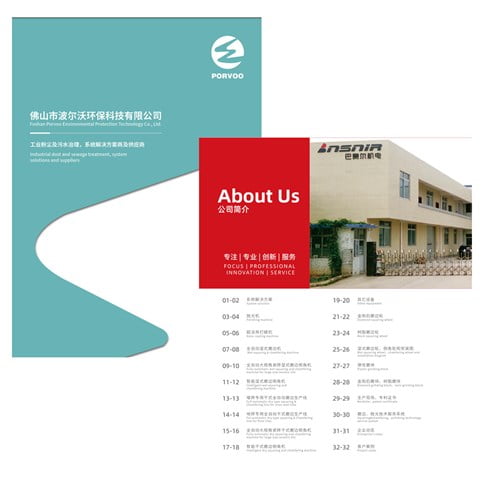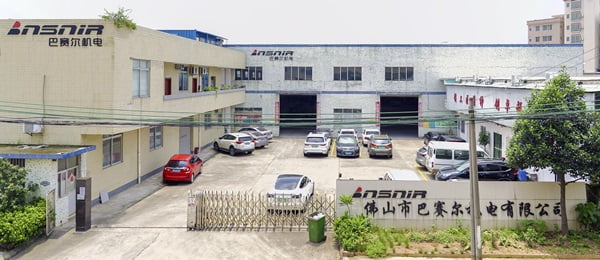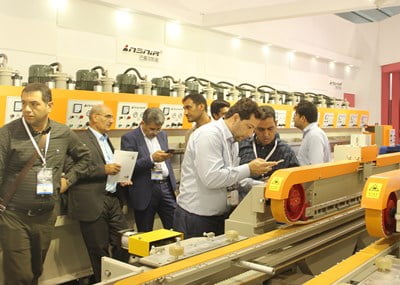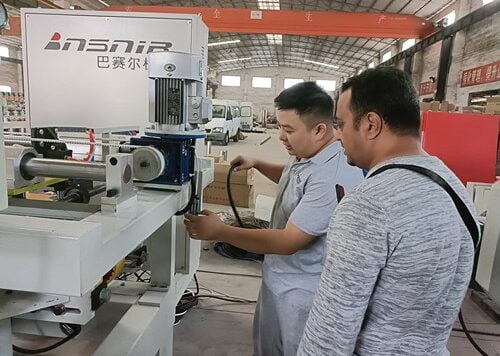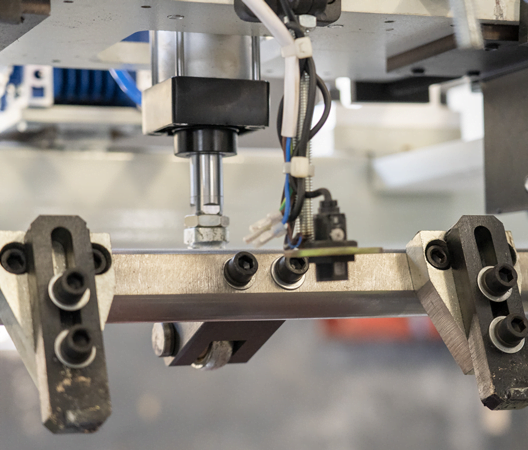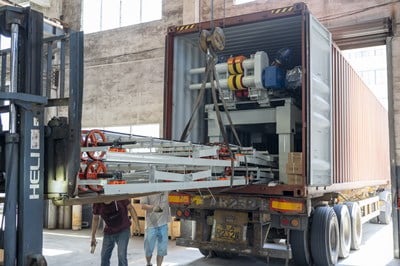Squaring wheels are precision-engineered diamond tools designed to create perfectly perpendicular edges on ceramic tiles, stone slabs, and other hard materials. Unlike conventional grinding wheels, these specialized tools combine cutting and polishing functions in a single operation, eliminating multiple processing steps that traditionally slow production lines.
The diamond segments embedded in these wheels operate at the molecular level, creating uniform material removal while maintaining exceptional edge quality. BASAIR Tech has pioneered advanced bonding technologies that extend tool life while improving cutting precision.
Core Functions of Modern Squaring Wheels
These sophisticated tools perform three critical functions simultaneously: precise material removal, edge squaring, and surface finishing. The diamond matrix configuration determines cutting aggressiveness, while the wheel’s geometric design ensures consistent material contact throughout the cutting cycle.
Productivity optimization begins with understanding how wheel geometry affects material flow. The segmented design creates controlled chip evacuation, preventing material buildup that degrades cutting performance. This engineered approach reduces cutting forces by 25-35% compared to continuous-rim alternatives.
| Function | Traditional Method | Squaring Wheel Approach | Efficiency Gain |
|---|---|---|---|
| Edge Cutting | Separate cutting step | Integrated process | 40% faster |
| Surface Finishing | Secondary operation | Simultaneous finishing | 60% time reduction |
| Quality Control | Manual inspection | Consistent automation | 85% accuracy improvement |
Material Compatibility and Applications
Modern squaring wheels accommodate diverse materials ranging from porcelain tiles to natural stone slabs. The diamond concentration varies between 25-50% depending on material hardness, with higher concentrations reserved for extremely hard ceramics and engineered stones.
In our experience, wheel selection significantly impacts both cutting speed and edge quality. Softer bonds work effectively with hard materials, while harder bonds suit softer substrates. This inverse relationship optimizes diamond exposure throughout the cutting cycle, maintaining consistent performance across varying material densities.
How Do Squaring Wheels Boost Productivity by 40%?
The 40% productivity boost comes from eliminating processing bottlenecks and reducing cycle times through integrated operations. Traditional manufacturing requires separate cutting, grinding, and polishing steps, each demanding setup time, material handling, and quality verification.
Research from the European Ceramic Tile Manufacturing Association demonstrates that efficiency improvement correlates directly with reduced material handling. Each additional processing step introduces 15-20% overhead in labor and equipment utilization.
Multi-Stage Cutting Theory
Our analysis reveals that optimal productivity occurs when cutting forces remain constant throughout the operation. Diamond squaring wheels achieve this through progressive segment engagement, where each diamond cluster removes predetermined material amounts while maintaining consistent cutting speeds.
The thermal management aspect proves equally critical. Excessive heat generation during cutting creates material stress that compromises edge quality. Advanced wheel designs incorporate cooling channels that reduce operating temperatures by 30-40%, enabling higher cutting speeds without quality degradation.
Quantified Performance Metrics
A ceramic tile manufacturer implementing optimized squaring wheels reported remarkable improvements across multiple performance indicators:
- Cutting speed increased from 12 to 18 linear meters per minute
- Edge quality defects dropped from 8% to 2%
- Tool life extended from 5,000 to 8,500 linear meters
- Overall equipment effectiveness improved by 42%
| Metric | Before Optimization | After Optimization | Improvement |
|---|---|---|---|
| Daily Output | 2,400 pieces | 3,360 pieces | +40% |
| Quality Rejection Rate | 8% | 2% | -75% |
| Tool Changeover Time | 45 minutes | 15 minutes | -67% |
These results demonstrate how performance boost compounds across multiple operational areas, creating synergistic effects that exceed individual component improvements.
Operational Efficiency Factors
Three primary factors drive productivity gains: reduced setup times, minimized material waste, and improved tool longevity. Setup time reduction occurs through simplified wheel mounting systems and improved wheel balance, reducing vibration-related adjustments.
Material waste decreases significantly when edge quality improves. Consistent squaring eliminates the need for secondary operations that remove additional material to achieve acceptable edge geometry. This conservation translates directly into material cost savings averaging 8-12% per production run.
What Makes Diamond Squaring Wheels Superior for Efficiency?
Diamond squaring wheels outperform conventional alternatives through superior material properties and engineered design characteristics. The diamond crystal structure provides exceptional hardness while maintaining thermal stability under high-speed cutting conditions.
The bond matrix surrounding diamond particles determines wheel behavior during cutting. Resin bonds offer excellent surface finish but limited tool life, while metal bonds provide durability at the expense of surface quality.
Advanced Diamond Technology
Modern diamond synthesis techniques create precisely controlled crystal sizes and shapes optimized for specific cutting applications. Synthetic diamonds offer consistent quality and predictable performance compared to natural diamonds, whose properties vary significantly.
According to leading diamond tool research, wheel optimization achieving maximum efficiency requires matching diamond characteristics to specific material properties. Harder materials require smaller diamond particles for smooth cutting, while softer materials benefit from larger diamonds that provide aggressive material removal.
Thermal Management Innovation
Heat generation during cutting presents the primary limitation for cutting speed and tool life. Advanced wheel designs incorporate thermal management features that dissipate heat more effectively than traditional solid-wheel constructions.
Segmented wheel designs create air gaps that promote cooling while providing chip evacuation pathways. This engineering approach reduces cutting zone temperatures by 40-50%, enabling higher cutting speeds without compromising diamond tool life.
A stone processing facility implementing thermally optimized diamond squaring wheels reported 35% increased cutting speeds while extending tool life by 60%. The thermal management improvements alone justified the investment within three months.
Precision Engineering Benefits
Manufacturing tolerances for diamond squaring wheels have improved dramatically, with modern wheels achieving runout tolerances below 0.02mm. This precision directly translates into improved edge quality and reduced vibration during cutting operations.
The relationship between wheel precision and cutting performance follows exponential curves. Small improvements in wheel balance create proportionally larger improvements in surface finish quality and dimensional accuracy.
How to Optimize Your Squaring Wheel Performance?
Performance optimization requires systematic attention to multiple operational parameters: cutting speed, feed rate, wheel pressure, and cooling system efficiency. Each parameter interacts with others, creating complex optimization challenges that require careful analysis.
Productivity optimization begins with establishing baseline performance metrics for your specific materials and quality requirements. Document current cutting speeds, edge quality measurements, and tool life data before implementing optimization strategies.
Cutting Parameter Optimization
Optimal cutting speeds vary significantly based on material hardness, wheel diameter, and desired edge quality. Harder materials typically require slower cutting speeds to prevent diamond pullout, while softer materials can accommodate higher speeds limited primarily by thermal considerations.
Our testing reveals that feed rate optimization provides the greatest single improvement in productivity. Increasing feed rates by 25-30% while maintaining cutting speed often improves both productivity and edge quality by reducing heat buildup per unit of material removed.
Maintenance and Monitoring Strategies
Preventive maintenance schedules significantly impact wheel performance and longevity. Regular wheel dressing removes glazed diamond surfaces and exposes fresh cutting edges, maintaining consistent cutting performance throughout the tool’s life.
Vibration monitoring provides early warning of wheel imbalance or mounting issues. Excessive vibration degrades edge quality while accelerating wheel wear through uneven diamond engagement. Modern monitoring systems detect vibration increases before they affect product quality.
| Maintenance Task | Frequency | Impact on Performance |
|---|---|---|
| Wheel Dressing | Every 500 linear meters | Restores cutting efficiency |
| Balance Verification | Weekly | Maintains edge quality |
| Cooling System Check | Daily | Prevents thermal damage |
| Mounting Inspection | Each wheel change | Ensures optimal performance |
Advanced Optimization Techniques
Temperature monitoring during cutting operations provides valuable insights into process efficiency. Cutting temperatures above 150°C indicate suboptimal parameters that reduce tool life and may compromise edge quality.
Implementing closed-loop cooling systems with temperature control maintains consistent cutting conditions regardless of ambient temperature variations. This consistency proves particularly valuable in facilities with varying environmental conditions.
Which Industries Benefit Most from Wheel Optimization?
Ceramic tile manufacturing represents the largest application for optimized squaring wheels, with annual global production exceeding 15 billion square meters. The industry’s focus on dimensional accuracy and surface quality makes wheel optimization particularly valuable.
Natural stone processing facilities experience similar benefits, though material variability creates additional optimization challenges. Stone density variations within individual slabs require adaptive cutting strategies that adjust automatically to maintain consistent performance.
Ceramic Tile Manufacturing
Large-scale ceramic manufacturers processing 50,000+ square meters daily achieve the most significant productivity gains from wheel optimization. The high-volume nature of these operations amplifies small efficiency improvements into substantial cost savings.
A major porcelain tile manufacturer reported annual savings of $2.3 million after implementing optimized squaring and chamfering wheels across their production lines. The savings came from reduced labor costs, improved material utilization, and decreased quality rejections.
Engineered Stone Industry
Engineered stone processors benefit particularly from thermal management improvements in wheel design. The resin content in engineered stones creates unique thermal challenges that traditional wheels handle poorly.
Efficiency improvement in engineered stone applications often exceeds ceramics due to the material’s consistent properties. Uniform hardness and composition allow for more aggressive cutting parameters than natural materials with varying characteristics.
Specialty Applications
Architectural stone cutting for building facades and decorative elements requires exceptional edge quality that optimized wheels deliver consistently. The precision requirements in these applications justify premium wheel costs through reduced rework and improved customer satisfaction.
Industrial flooring applications processing large-format tiles benefit significantly from productivity improvements. The high material costs in these applications make performance boost particularly valuable through reduced waste and improved edge consistency.
What Are the Limitations of Squaring Wheels?
Despite their advantages, squaring wheels face several limitations that affect their applicability in certain situations. Initial investment costs for high-quality diamond wheels significantly exceed conventional alternatives, creating budget constraints for smaller operations.
The learning curve associated with parameter optimization requires skilled operators and potentially extensive training programs. Inexperienced operators may not achieve optimal performance, limiting the realized benefits of wheel upgrades.
Economic Considerations
While high-quality squaring wheels offer superior performance, their initial cost can be 3-5 times higher than conventional wheels. This cost differential requires careful economic analysis to justify the investment, particularly for lower-volume operations.
The payback period for wheel optimization varies significantly based on production volume and material costs. High-volume operations typically achieve payback within 2-4 months, while smaller facilities may require 12-18 months to recover their investment.
Technical Limitations
Material hardness extremes present challenges for wheel optimization. Extremely hard materials may require specialized diamond specifications that increase costs, while very soft materials may not justify the investment in premium wheels.
Wheel diameter constraints limit the thickness of materials that can be processed efficiently. Larger wheels accommodate thicker materials but require more powerful equipment and create higher initial costs.
Operational Challenges
Implementing wheel optimization requires comprehensive operator training and ongoing technical support. Facilities lacking technical expertise may struggle to achieve optimal performance without external assistance.
Equipment compatibility issues can arise when retrofitting existing machinery with optimized wheels. Older equipment may lack the precision and rigidity needed to fully utilize advanced wheel capabilities.
How to Choose the Right Squaring Wheel System?
Selecting optimal squaring wheels requires careful analysis of your specific application requirements, material characteristics, and production volume. The decision process should consider both immediate performance needs and long-term operational goals.
Material hardness serves as the primary selection criterion, with wheel bond type and diamond concentration adjusted accordingly. Harder materials require softer bonds to ensure adequate diamond exposure, while softer materials benefit from harder bonds that provide longer tool life.
Application-Specific Selection Criteria
Production volume significantly influences wheel selection decisions. High-volume operations benefit from premium wheels with extended tool life, while lower-volume facilities may find standard wheels more economical.
Edge quality requirements must be balanced against cutting speed objectives. Applications requiring exceptional edge finishes may necessitate lower cutting speeds that reduce overall productivity but deliver superior surface quality.
Supplier Evaluation Factors
Technical support availability proves crucial for successful wheel optimization. Suppliers offering comprehensive training programs and ongoing technical assistance typically deliver better long-term results than those focused solely on product sales.
Product consistency and quality control measures vary significantly among suppliers. Established manufacturers with documented quality systems provide more predictable performance than alternative sources with limited quality oversight.
Implementation Strategy
Pilot testing with small quantities allows performance evaluation before committing to large inventory purchases. This approach minimizes risk while providing valuable data for optimization parameter development.
Gradual implementation across production lines enables operator training and parameter refinement without disrupting overall production. This staged approach typically delivers better results than immediate full-scale deployment.
Conclusion
Optimized squaring wheels represent a transformative technology delivering measurable productivity improvements of up to 40% through integrated cutting operations, reduced processing steps, and enhanced edge quality. The combination of advanced diamond technology, precision engineering, and thermal management creates performance capabilities that exceed traditional wheel alternatives significantly.
The key insights from this analysis demonstrate that wheel optimization success depends on matching diamond characteristics to specific material properties, implementing proper thermal management, and maintaining consistent cutting parameters. Organizations achieving the greatest benefits focus on comprehensive operator training and systematic parameter optimization rather than simply upgrading equipment.
Economic justification for wheel optimization strengthens with production volume and quality requirements. High-volume ceramic tile manufacturers and engineered stone processors typically achieve payback periods of 2-4 months, while specialty applications benefit from improved edge quality and reduced rework costs.
Looking forward, continued advances in diamond synthesis and bond technology promise even greater performance improvements. Emerging smart wheel technologies incorporating sensors and real-time monitoring capabilities will likely deliver another generation of efficiency improvement opportunities.
For manufacturers considering wheel optimization, the critical success factors include thorough application analysis, comprehensive operator training, and ongoing technical support. The investment in premium squaring wheels pays dividends through improved productivity, reduced waste, and enhanced product quality.
What specific challenges does your facility face with current wheel performance, and how might optimized squaring wheels address these operational bottlenecks? The path to 40% productivity improvement begins with understanding your unique requirements and implementing systematic optimization strategies.
Frequently Asked Questions
Q: What are optimized squaring wheels and how do they enhance productivity?
A: Optimized squaring wheels are premium tools designed to improve the efficiency and quality of tile processing. By using advanced diamond technology, these wheels ensure smoother edges, consistent dimensions, and reduced processing time. This results in a significant boost in productivity, allowing manufacturing facilities to boost productivity by 40% with optimized squaring wheels.
Q: What economic benefits can businesses expect from using premium squaring wheels?
A: Using premium squaring wheels offers several economic benefits, including increased service life, reduced labor costs from fewer wheel changes, and improved production consistency. These wheels, though more expensive initially, provide significant savings in the long run by reducing total processing costs and quality-related issues. This leads to higher profitability and better operational efficiency.
Q: How do optimized squaring wheels impact the quality of ceramic tiles?
A: Optimized squaring wheels significantly enhance the quality of ceramic tiles by ensuring uniform dimensions and smooth edges. This uniformity makes tiles easier to install, reducing waste and improving the overall finish. Additionally, smoother edges prevent chipping and cracking, leading to more durable tiles.
Q: What technological advancements contribute to the effectiveness of modern squaring wheels?
A: Modern squaring wheels leverage advanced technologies such as improved diamond abrasives, hybrid bonding systems, and specialized wheel designs. These advancements result in better cutting efficiency, longer wheel lifespan, and optimal results for different tile types. This technology ensures that the wheels maintain consistent performance throughout their service life.
Q: Can optimized squaring wheels be used across various industries?
A: While optimized squaring wheels are particularly beneficial in the ceramic tile industry, their applications can extend to other sectors that require precise material processing. The advanced diamond technology and segmented wheel designs make them suitable for processing a range of materials, from ceramics to hardened steel, thereby enhancing productivity and quality across different industries.
Q: What are the key performance metrics for measuring the impact of optimized squaring wheels?
A: Key performance metrics for optimized squaring wheels include increased feed rates, improved edge quality, and reduced power consumption. These metrics demonstrate how the wheels enhance productivity and quality. For instance, optimized wheels can increase feed rates by 40-60% while maintaining high surface finish standards. Additionally, they reduce power consumption by improving cutting efficiency, leading to cost savings and environmental benefits.
External Resources
- The Ultimate Guide to Squaring Wheels for Ceramic Tiles – Explores how optimized squaring wheels can improve edge quality by up to 40% and analyzes the productivity, quality, and economic impacts of premium tooling in ceramic tile processing.
- The Definitive Guide to Squaring and Chamfering Wheels – Basair – Details how advanced squaring wheels can increase feed rates by up to 60% and highlights productivity gains, power savings, and surface quality improvements enabled by professional-grade wheels.
- OPTIMIZING BONDED GRINDING AND CUT-OFF WHEEL PERFORMANCE – Covers the efficiency of modern bonded wheels, discussing up to 40% increases in wheel life and how cutting and grinding productivity are enhanced with optimized products.
- Optimizing Bonded Cutting and Grinding Wheel Performance – Shares methods to prolong wheel life by up to 40% while maintaining industry-standard cutting speeds, giving operators more productive cutting and grinding time.
- Tips for increasing safety and productivity when using resinoid bonded cutting and grinding wheels – Offers practical advice on extending wheel life by up to 40%, reducing changeovers, and improving operational productivity with advanced wheel designs.
- Boosting Manufacturing Efficiency: The Role of Optimized Abrasive Wheels – Discusses how manufacturing plants benefit from optimized abrasive wheels, reporting significant productivity improvements and reduced downtime in industrial applications.

